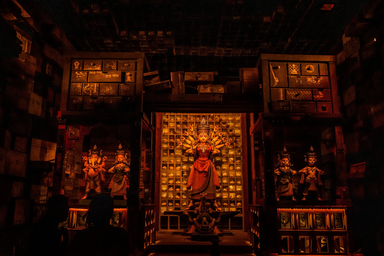The common assumption in the status quo is that for a woman, being religious comes with the burden of oppression by archaic thoughts and ideals. However, it is important for us to question whether the newfound oppressive definition of religion has come from a man’s whim or what religion truly was in its purest form. This requires one to view the world from an objective standpoint to realise that while patriarchal elements are almost indistinguishably intertwined into the fabric of religion, cherry-picking the virtues of religion that inspire and empower the modern-day disciple is what ensures everyone’s mental peace. This ideal can be found in certain goddesses, such as Draupadi, Lilith and Tara, who prove to be role-models and embody the principles of the feminist movement.
- Draupadi
-
Within the delicately adorned walls of Singapore’s Sri Mariamman Temple resides a statue of Draupadi, a Hindu goddess, surrounded by her five husbands. The glimmer in the statue’s eyes conceals the ordeal Draupadi had faced. The pivotal episode in her lore was when her husband waged and later lost in her a game of dice. She was dragged by her hair into open court, where a perpetrator tried to strip off her sari. This insult and humiliation acted as the trigger of the great epic Mahabharata. After she was vindicated by his death at the eighteen-day battle at Kurukshetra, society’s obsession with women’s virginity forced her to walk unharmed through fire to prove her chastity. Despite these experiences, Draupadi was not in the least deterred and continued to display her individuality and unyielding determination for justice, hence becoming an empowering character.
An in-depth understanding of Draupadi’s narrative reveals that the feminist concept of subversion is used to undermine patriarchal institutions and the commodification of women. To subvert something is to take oppressive forces and turn them into something that challenges the oppressor. This becomes apparent when her husbands lose her in a game of dice to a man who tries to disrobe her. During that incident, she subverts the concept of equating feminine honour with a virgin or inviolate body, an important lesson today when victim-blaming and shaming are rampant.
- Lilith
-
Finding empowering role models from the realm of religion isn’t as rare as I had previously assumed. For example, the traditionally patriarchal retelling of Lilith’s lore portrays her in a demonising light, quite literally. However, studied through an unprejudiced lens, she undoubtedly personifies a realistic female role-model: she values her independence above all else, defies social norms imposed by the patriarchy, and knows she doesn’t owe any man, not even God, an explanation.
According to Jewish texts, Lilith was the first woman and Adam’s first wife, created out of the earth just like Adam was and thus, his equal. She wished to make her own decisions and explore the world that God had created. Story-tellers portray her departure from Eden as an act of defiance and emphasise her punishment for it in an attempt to differentiate the socially acceptable submissive wife, Eve, from the defiant demonic figure. However, Lilith simply chose the lesser of two evils in placing her freedom over the punishment meted out to her by God, that one hundred of her children would be killed every day. Her rage is demonised, but she was perfectly justified in being upset at the harsh penalty. Lilith’s story evinces that she was unfairly demonised, not unlike most women in history who attempted to defy the patriarchy whether as a demonic figure or a symbol of women’s struggle.
- Tara
-
Letting go of the “not like other goddesses” syndrome, not all role-models need to be rebellious or tough to be empowering; some can be badass in their own kind way. Tara, the goddess of compassion and action, and one of the few women to attain enlightenment, significant in Tibetan Buddhism, embodies this thought. ‘Tara’, meaning star, alludes to how she is said to serve as a guiding light for followers. Tara is said to have many embodiments, the best known however are the peaceful White Tara who protects and brings long life, and the dynamic Green Tara, who is Mother Earth and who alleviates suffering.
Most of Tara’s lore is set in an era in India characterised by being sociologically transformative as Buddhism had women teaching men, commemorating the dawn of female buddhas. Once, when she was close to enlightenment, a man expressed his pity on her for being in the body of a woman as she would have to return as a man before becoming enlightened. Tara, refuting his hollow sexist comment, says, “Here there is no man; there is no woman, no self, no person, and no consciousness. Labelling ‘male’ or ‘female’ is hollow. Oh, how worldly fools delude themselves.” The importance of her words in breaking gender norms is representative of the fact that she is relevant in recent dialogue about gender as a social construct and the role of men and women in society.
Epics and holy books are dedicated to goddesses whose legends portray them as independent, fiercely protective women. They are exploited and mistreated by men but eventually avenge themselves with courage and integrity. This is juxtaposed by societies where the traditionally patriarchal status of women grants them negligible independence or identity separate from their fathers and husbands. Thus, women need role-models due to the gender biases, institutional barriers and negative stereotypes they have long faced. Simply put, “seeing is believing”. When women and young girls, especially those with limited access to media where more mainstream role-models like politicians or sportswomen are glorified, see goddesses they worship oppose patriarchal forces for equity and to maintain their individuality, they may be motivated to unshackle themselves from the fetters of injustice.
These goddesses break patriarchy’s shackles of equating virginity with feminine honour without giving heed to gender relations and being independent of male consorts, admirable qualities which young women can emulate. However, they have not experienced more modern problems like social media’s unrealistic beauty standards and other such pressures that women today face. Keeping in mind their times, the goddesses are holistic role-models; they, however, lack the currency that a contemporary role-model can offer. Perhaps, if they were placed in today’s context, we would find them marching in candle vigils and representing women’s rights movements. But until bringing mythical goddesses to life is possible, we must give prominence to women currently in leadership roles to inspire us and serve as role-models to young women globally.


